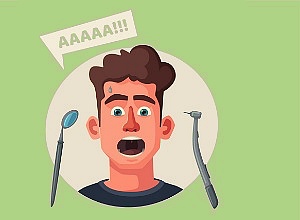Roughly half of New York dentists surveyed experienced verbal or reputational aggression by patients in the past year, and nearly one in four endured physical aggression. according to a study led by researchers at New York University College of Dentistry.
The study is the first to document aggression toward dentists in the US.
Workplace aggression toward health care professionals is common, with health care settings second only to law enforcement in the rate of violent incidents. However, there are no studies of aggression toward dentists in the US – a workforce of 200,000 – and only four studies have been conducted in other countries.
"Workplace violence toward health care professionals is both widespread and widely overlooked," said Kimberly Rhoades, a research scientist in the Family Translational Research Group at NYU College of Dentistry and the study's lead author. "The purpose of this study was to provide an initial estimate of rates of patient aggression in dental practices in the US."
Rhoades and her colleagues surveyed 98 dentists practicing in the New York City metropolitan area; the dentists had been working an average of 17 years. Participants completed a confidential online survey assessing whether they had experienced any of 21 specific types of aggressive behaviours from their patients, including types of physical (being pushed or kicked), verbal (being insulted or sworn at), and reputational (threats of lawsuits or posting nasty comments on social media) aggression.
A substantial proportion of dentists reported experiencing aggression from patients in the past year, including physical (22.2%), verbal (55%), and reputational (44.4%) aggression. An even larger proportion of dentists surveyed were subjected to physical (45.5%), verbal (74%), and reputational (68.7%) aggression at some point during their career. These rates of patient aggression toward dentists are high and comparable with those reported in other health care settings.
Rates of aggression did not differ by dentists' sex, race, ethnicity, specialty, age, years practicing, or average number of patients treated per day.
The rates of physical and reputational aggression toward dentists were similar to those from a parallel study by NYU researchers of aggression toward dental students published earlier this year. However, practicing dentists experienced less verbal aggression from patients than dental students (55% versus 86%), suggesting that additional experience may reduce the risk of verbal aggression.
"Dentistry is rife with situations that can elicit strong negative emotions, such as fear, pain, distrust, and anger. Many patients also experience high levels of anxiety and vulnerability, which may increase negative responses or aggression," said Rhoades.
"Establishing that aggression toward dentists is a problem and how often it occurs can help us develop interventions to prevent aggression in dental practices."
The researchers note that, while a larger, national study is needed to determine the true prevalence of aggression in US dental settings, dental practices should consider implementing training that incorporates strategies for handling workplace violence. Training could address how to prevent patient aggression, and manage or de-escalate aggression when it does occur.
Abstract
Background: Workplace violence toward health care professionals is both widespread and widely overlooked. Only 4 studies of aggression toward dentists have been published—none in the United States—with the prevalence of aggression ranging from 29% through 80%. The purpose of this study was to provide an initial estimate of rates of patient aggression in dental practices in the United States.
Methods: The authors surveyed 98 dentists recruited from the faculty and alumni network of a college of dentistry. Participants completed a confidential online survey assessing whether they had experienced any of 21 specific types of aggressive behaviors from their patients.
Results: Past-year aggression prevalence was 22.2%, 55.0%, and 44.4% for physical, verbal, and reputational aggression, respectively. Career prevalence was 45.5%, 74.0%, and 68.7% for physical, verbal, and reputational aggression, respectively. Rates did not differ by sex, race, ethnicity, specialty, age, years practicing, or average number of patients treated per day.
Conclusions: Participants reported levels of physical, verbal, and reputational aggression at rates comparable with those of other health care professionals in the United States and abroad. Additional research with larger representative samples of dentists in the United States is necessary to confirm these prevalence estimates. Future research should also investigate predictors and outcomes of patient aggression and prevention and intervention strategies.
Practical Implications: Substantial rates of patient aggression highlight the need to address this problem in dental practices. The authors discuss implications for the dental profession, including proactive steps that could be taken to reduce patient aggression in dental offices.
Authors
Kimberly A Rhoades, Richard E Heyman, J Mark Eddy, Nicole C Haydt, Jacqueline E Glazman, Zachary F Dispirito, Sammie Jo Fat, Charlotte M Guerrera, Allison N Rascon, Mark S Wolff
[link url="https://www.nyu.edu/about/news-publications/news/2020/october/dentists-aggression-from-patients.html"]New York University material[/link]
[link url="https://jada.ada.org/article/S0002-8177(20)30532-8/fulltext"]Journal of the American Dental Association abstract[/link]

